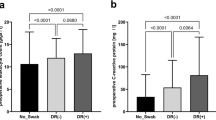Abstract
Background
The clinical effectiveness of pus swabs for microbiological analysis during incision and drainage of perianal abscess is controversial. Its cost implication is often overlooked. The present study aimed to determine if submission of pus swabs can be avoided without a negative effect on outcome.
Methods
All consecutive cases of incision and drainage of perianal abscess between January 2004 and 2008 were retrospectively reviewed. Patient demographics, microbiological results, and clinical outcome with a follow-up of 6 months were assessed.
Results
A review of patient records revealed 235 cases (59 F:176 M; age range: 6–99 years; median: 37 years). In 38 cases no swabs were taken; in 28 cases (12%), 106 cases (45%), and 16 cases (7%) swabs contained skin flora organisms, coliform/Bacteroides, and sterile, respectively. Within 6 months follow-up, 185 of the abscesses had healed, leaving 39 cases of fistula (25 cases had setons remained in situ for their fistulas at 6 months follow-up) and 11 patients were lost from follow-up. Fistulas were not associated with coliform/Bacteroides found on microbiological analysis (P > 0.05). In only 4 cases (1.7%) were the swab results mentioned in follow-up reports.
Conclusions
Surgeons tend not to review microbiological results at patient follow-up. Furthermore, the preliminary findings suggest that microbiological results have no correlation with presence of fistulas or prognosis. Randomized controlled trials are warranted to assess whether abandoning submission of pus swabs will affect clinical effectiveness of treatment in patients with perianal abscess.



Similar content being viewed by others
References
Vasilevsky CA, Gordon PH (2007) Benign anorectal sepsis. In: The ASCRS textbook of colon and rectal surgery, vol 13. 192 pp
Parks AG, Gordon PH, Hardcastle JD (1976) A classification of fistula-in-ano. Br J Surg 63:1–12
Grace RH (1990) The management of acute anorectal sepsis. Ann R Coll Surg Engl 72:160–162
Mandell M (1994) Not documented, not done. Nursing 24:62–63
Eykyn SJ, Grace RH (1986) The relevance of microbiology in the management of anorectal sepsis. Ann R Coll Surg Engl 68:237–239
Brook I, Frazier EH (1997) The aerobic and anaerobic bacteriology of perirectal abscesses. J Clin Microbiol 35:2974–2976
Acknowledgments
The authors are grateful to Dr. Vishaal Bedi for the initial data collection.
Author information
Authors and Affiliations
Corresponding author
Rights and permissions
About this article
Cite this article
Leung, E., McArdle, K. & Yazbek-Hanna, M. Pus Swabs in Incision and Drainage of Perianal Abscesses: What Is the Point?. World J Surg 33, 2448–2451 (2009). https://doi.org/10.1007/s00268-009-0190-4
Published:
Issue Date:
DOI: https://doi.org/10.1007/s00268-009-0190-4




